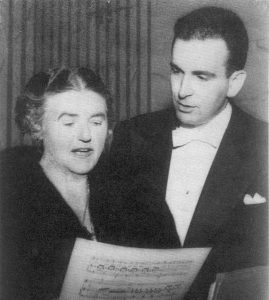
Recordings You can listen to every commercial recording made by Lehmann from 1914–1949. These are in mp3 format.
You can read what critics wrote of Lehmann’s Lieder recordings found in Song on record from 1986. I’ve included the actual recording so that you can hear what the writers are referring to.
Special Aria or Song A concentrated account of a particular opera aria or the cycles, Winterreise, Dichterliebe, and Die schöne Müllerin with Lehmann’s own paintings and recitation, as well as her singing and teaching.
Compare Lehmann’s live vs. studio recordings.
You can hear the favorite Lehmann recordings of critics, reviewers, and fans.
You can hear (and see) Lehmann sing in excerpts from her MGM movie Big City (1948).
Listen to Lehmann “live” in radio broadcasts of the 1940s. I’ve chosen fast moving Lieder. Some are Lieder that she never recorded in studio, and all featuring Lehmann’s unmistakable emotional commitment.
Songs in English Since many of the visitors to this site speak English, this can be an especially nice introduction to the world of Lehmann.
Light songs and operetta The division between “art” music and light music wasn’t so distinct in Lehmann’s time and she sang and recorded a lot of pop-like songs.
You can enjoy a radio broadcast of Lehmann singing Schubert’s “Ungeduld” from Die schöne Müllerin with string orchestra accompaniment. It’s “live” as you’ll hear with the applause at the end .
Lehmann sings four Strauss Lieder and two encores with orchestra at the Hollywood Bowl, Eugene Ormandy conducting from 5 August 1948, complete with introductions, applause, and commentary.
Hear how Lehmann sang Schubert’s “Ständchen” (Leise flehen…) from 1927–1950.
Lehmann’s performances of Schubert’s “Der Doppelgänger” with article by Macaulay.
Lehmann’s recordings of Schumann’s Frauenliebe und -leben (1924 – 1946)
Herman Klein reviews of Lehmann records 1924-1934 that you can also hear.
Hear Lehmann as the Marschallin in the live 1939 Met Der Rosenkavalier (excerpts) with commentary
Listen for the difference sound engineers can make on these following radio broadcast recordings. Mostly Lieder, but you’ll also find Puccini, Wagner, etc.
The 1940 Met (in Boston) Die Walküre (excerpts) with commentary is now available in decent sound. You can also listen to the complete 16 January 1937 Metropolitan Opera performance of Wagner’s Die Walküre with Lehmann as Sieglinde, Melchior, Siegmund, et al. The noise level and the broken bits can be annoying, but the singing/acting that you’ll be able to decipher is beyond anything that you may have heard. A whole page, Die Walküre, offers excerpts from the 1935 classic recording conducted by Bruno Walter, as well as reviews of that set, and other Die Walküre-related material. You can hear excerpts from the live recording of Die Walküre with the Vienna Staatsoper from 14 September 1933 with Jeritza, LL, Völker, and Schorr with Krauss, conducting. The sound isn’t great, but in the few Lehmann excerpts we hear, she lives up to her reputation as a real actress.
For the Lehmann completest, we have a few seconds of her singing as Eva in Die Meistersinger conducted by Toscanini at the Salzburg Festival of 1936. You’ll hear the tenor sing the prize song twice and then Lehmann sings a bit at 3:24. And you can also hear a slightly cleaned up version of the acoustically horrible (but exciting) short-wave broadcast of Toscanini conducting Lehmann in the Abscheulicher and Komm’ Hoffnung from the Fidelio of 16 August 1936.
Perhaps also for the completest, though some of the recordings are difficult to listen to, we offer excerpts from Vienna Opera performances with Lehmann of: Die Meistersinger, Tannhäuser, Andrea Chenier, Die Walküre and Der Rosenkavalier.
We have a whole page dedicated to a live concert Lehmann performed with the Seattle Symphony Orchestra in 1946. The orchestra doesn’t sound professional, the recording is poor, and since it was performed outdoors (in the University of Washington Stadium), there’s ambient noise. But Lehmann sings well, despite everything. Schubert’s Die junge Nonne, Der Jungling an der Quelle, and Der Erlkönig. She also performs Wagner’s Träume, from his Wesendonck Lieder.
Many songs on the Bruno Walter Society LP have never found their way to CD. Here’s that 22 minute recording. BWS LP; many of these songs appeared on the LP odyssey Mono 32 16 0179. In any case, the recordings can be also heard in the “Sound” Discography on this site.
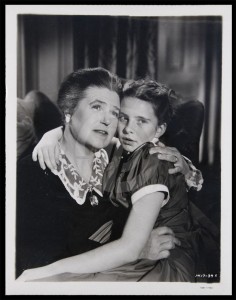
Here’s a section from the movie that Lehmann made: MGM Movie Clip: BigCity You can also see her sing a portion of the Kerry Dances.
You can hear the 6 January 2015 presentation called “Lotte Lehmann, Legendary and Unknown” prepared by Gary Hickling for the Vocal Record Collectors Society. The presentation included Lehmann singing well known as well as rare aspects of her repertoire. Gary Hickling provided the introductions to each selection Part One. Part Two. It lasts just over 30 minutes.
Lehmann CDs: A list of her CDs and their contents.
Famous Conductors with whom Lehmann Sang
Comparisons It’s always interesting to hear how Lehmann sounds in comparison with others of her time and ours.
Roles & Repertoire One can view the roles that Lehmann sang on the opera stage, how many times she sang them and when she first essayed them. The list of her art song (Lieder) repertoire is also available there.
Discography This discography is useful for those who want the details of matrices, takes, and recording dates. The first listed “Recordings” above offers a simplified “discography” with the sound recording for each entry.
Missing Recordings These are radio broadcasts for which we have little or no sound documentation. Keep your eyes out!
Here’s a live excerpt of Lehmann in the final Die Meistersinger quintet: Selig wie die Sonne_with the Vienna Opera conducted by Weingartner in 1935 in quite bad sound, but fun to hear on the stage. YouTube has posted a really well-filtered version of one of Lehmann’s most popular recordings, the 1924 acoustic of Korngold’s famous duet from Die tode Stadt with Richard Tauber.
Live Winterreise?
• A Detective Story: Searching for Lehmann Live
A young Frenchman living in Lyon has spent years searching for the fabled Lotte Lehmann Winterreise broadcast of one of Lehmann’s last Town Hall recitals of 1951. Christophe Pizzutti’s quest was rewarded when he uncovered a wire recording, (yes, when a tape recording wasn’t available wire was used) that purported to be of this very broadcast. After considerable time, M. Pizzutti was able to procure this rare recording which could have been lost or destroyed without his intervention. He has been able to verify that the reel of wire that he received was indeed of the historic concert. M. Pizzutti writes: “the original media was fragile and unstable (wire recording is something of a nightmare, if the wire broke during the process, the sound is irreversibly lost).” In the end, it seems to be in excellent sound and almost complete. There may be some cuts due to the radio’s time limitations. A dedicated and sincere Lehmann fan, M. Pizzutti considers this culmination of his epic quest to be “one of the most beautiful” of his life.
The result of M. Pizzutti’s research has unearthed the only known live performance of Lehmann’s ground breaking Winterreise. She was the first female to attempt the Schubert cycle and, although many women have since then performed and recorded it, Lehmann’s venture was in her time deemed an affront to the wishes of Schubert and the poet, Müller. But even during World War II both RCA and Columbia regarded her Winterreise undertaking worth recording (in excerpts).
What will happen with this rare document? Some enterprising recording engineer, transfer specialist, or other techie will definitely want to work on the fragile wire copy of this Lehmann masterpiece and make it available to Lehmann fans.
Here are some of the reactions to excerpts from this find: “All your patience and good efforts have borne fruit. You must be thrilled. It’s a wonderful accomplishment. And with excellent sound too!” “My heart beats so much on the last verse of ‘Gute Nacht.’ So human. ‘Der Wegweiser’ is also impressive. It’s as if Lehmann is sharing something very secret and important to her.” “For me, one of the most beautiful moments in the history of sound recording.” “A musical and human great discovery.” “The quality of sound was a marvelous surprise. I never imagined that wire could have such a great sound.”
Lotte Lehmann sings Fidelio
Lotte Lehmann’s (1888-1976) debut performance as Leonore in Fidelio during the Beethoven Centenary in Vienna in 1927, was critically acclaimed as one of her greatest achievements and this performance comes from Berlin that same year with Manfred Gurlitt conducting. She sang the role for over a decade galvanizing audiences with her intensity. Eventually the tessitura of “Abscheulicher!” became difficult to sustain and she introduced a subtle half-step transposition to make the cruel final pages easier.
We hear Lehmann in two different performances – one done in the recording studio in her first year of singing the role abridged of the opening recitative. We hear a more youthful tone and this is a very human sized Leonore – not the grand tragedienne of her namesake Lilli. Her voice has a lower center and warmer tone than Lilli Lehmann but sits less securely on the breath – the long phrases of “Komm, Hoffnung” tax her but with an extra breath or two she manages well.

The live 1936 performance not only has Toscanini in the pit to match her fire, but also includes the opening recitative – sadly the acetates are in bad condition with faded sound and crackles. Also, Lehmann takes a long pause before the final section – one thinks the recording needle dropped off or technical issues with the recording. Clearly Lotte Lehmann’s dramatic authority would have kept the audience riveted even in the long silence as she seems to gather her strength for the final outburst (with the half tone transposition). Lotte Lehmann’s performing style was very “in the moment” suggesting that what we are seeing is happening spontaneously before us for the first time. It is lived rather than performed. This is why the live performance here is so telling and crucial that I included it along with the studio recording in fresher younger voice. [The sound is bad; it takes patience and imagination to enjoy what Lehmann offers. Remember, this is the only known source of her singing the introduction to the “Komm Hoffnung” aria “Abscheulicher…” and for that alone it’s worth the torment of listening through the static of a live Over-the-Atlantic short-wave radio broadcast preserved on acetates!]
Last Recital in Vienna
Below you’ll see an historic photo of Lehmann on the recital stage with Bruno Walter on October 1, 1937. This was to be the last time Lehmann would sing in Europe. Later that year, Lehmann traveled to the U.S., where she would sing at the Met and sing recitals. The next spring Hitler’s troupes marched into Vienna and annexed the whole country. Lehmann returned for the reopening of the Vienna Opera house in 1955, but had already stopped singing.
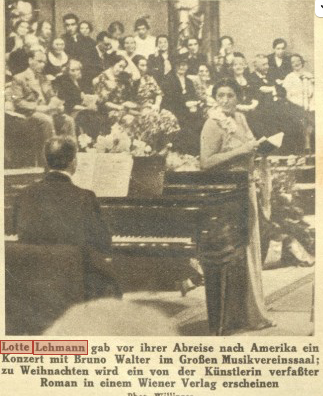
South American Tour 1922
Our Vienna friend and researcher, Peter Clausen, has sent a wonderful photo of the singers and the captain of the ship, that took them on their South American tour in 1922. You can find Lotte Lehmann: she is marked with the number 7, standing at the top of the group, just below number 6. In case you have difficulty reading the German script: 1. Is the conductor of the German contingent, Felix Weingartner; 2. His wife; 3. The Captain; 4. Kirchhoff; 5. Schipper; 6. Braun; 7. LL; 8. Bandler; 9. Wildbrunn; 10. Dr. Kaifer; 11. Bedjtein; 12. Hirn; 13. Mertens; 14. Herr Wildbrunn (husband of the soprano Helene Wildbrunn); 15. Impresario Schraml. Following that photo are two halves of an article about the trip that Herr Clausen has written out in German. I have tried my best to translate those words.
Herr Clausen has also helped with researching two Vienna culture magazines that offered many photos of Lehmann. You can see a condensed version of what we’ve worked on.

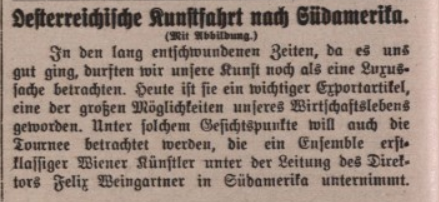
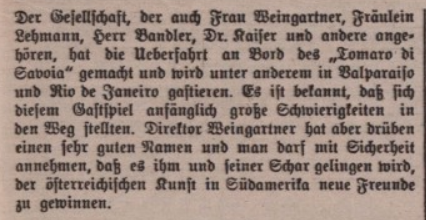
In den lang entschwundenen Zeiten, da es uns gut ging, durften wir unsere Kunst noch als eine Luxussache betrachten. Heute ist sie ein wichtiger Exportartikel, eine der groszen Moeglichkeiten unseres Wirtschaftslebens geworden. Unter solchem Gesichtspunkte will auch die Tournee betrachtet werden, die ein Ensemble erstklassiger Wiener Kuenstler unter der Leitung des Direktors Felix Weingartner in Suedamerika unternimmt.
Die Gesellschaft, der auch Frau Weingartner, Fraeulein Lehmann, Herr Bandler, Dr. Kaiser und andere angehoeren, hat die Ueberfahrt an Bord des “Tomaro di Savoia” gemacht und wird unter anderem in Valparaiso und Rio de Janeiro gastieren. Es ist bekannt, daß sich diesem Gastspiel anfaenglich große Schwierigkeiten in den Weg stellten. Direktor Weingartner hat aber drueben einen sehr guten Namen und man darf mit Sicherheit annehmen, daß es ihm und seiner Schar gelingen wird, der öesterreichischen Kunst in Suedamerika neue Freunde zu gewinnen.
In long ago times when we were doing well, we were still allowed to regard our art as a luxury thing. Today it has become an important export item, one of the great opportunities in our economic life. The tour undertaken by an ensemble of first-class Viennese artists under the direction of director Felix Weingartner to South America should also be viewed from this point of view.
The company, which also includes Mrs. Weingartner, Miss Lehmann, Mr. Bandler, Dr. Kaiser and others, made the crossing on board the “Tomaro di Savoia” and will be visiting Valparaiso and Rio de Janeiro, among other places. It is known that this guest performance initially met with great difficulties. But director Weingartner has a very good reputation over there and one can assume with certainty that he and his group will succeed in making new friends for Austrian art in South America.
